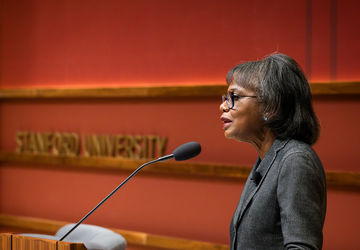Uncovering the gendered dimensions of job hunting
Imagine you have a once-in-a-lifetime opportunity to apply for your dream job, but there’s a catch: You have most—but not all—of the qualifications the employers want.
Do you take a chance and apply?
For Psychology PhD candidate and Clayman Institute Graduate Dissertation Fellow Fiona Lee, how you answer that question may depend on your gender. In studies she has conducted as part of her dissertation research, she has found that women show a reluctance to apply for jobs when they do not meet all the requirements listed in the job advertisement. Furthermore, women statistically express a greater need to fulfill all the noted job requirements in an advertisement before applying than men. This gender difference might reflect women’s belief that they need to be perfect in the eyes of potential employers in order to compete with men. More significantly, it also presents a barrier to women, as they may pass up chances to apply for jobs for fear of “not being qualified enough.”
Lee first became interested in this line of gender research while studying the planning process for goal achievement. She wanted to know why some people tackle their goals immediately, while others seem incapable of starting the process. Lee theorized there was something more than just procrastination at play. Perhaps, she thought, there may be an underlying factor that caused some people to be reluctant to get started before they feel perfectly ready.
This has led to Lee’s dissertation research that studies the gender differences in desire for professional preparedness. In pilot studies that simulated different scenarios of job applications and preparedness percentages, she confirmed a significant difference in the way that men and women expressed their willingness to apply for jobs. Women indicated they wanted to apply for jobs when they had a greater percentage of necessary qualifications, compared to what men indicated as their desired level of qualifications. Lee questioned whether gender differences would be observed for traditionally “feminine” jobs as well. When she tested again with gendered jobs like fashion design or computer programming, the gender gap remained significant across these different types of jobs.
Her study also asked participants to indicate whether a job was for women, for men, or for both, and to rate a job’s difficulty. In general, the level of preparation people wanted to have was related to the job’s perceived difficulty. Interestingly, men discriminated against jobs if they seemed “feminine,” and believed that “feminine,” “pink-collar” jobs were easier than jobs that are coded as masculine. In contrast, women didn’t see jobs coded by gender; compared to men, they were more likely to respond that jobs could be done by both men and women.
Lee’s research suggests minor changes in the language employers use could be effective in reducing gender differences in job application patterns. Through additional studies, Lee created mock job advertisements to reflect a recruiting company’s value on learning, inherent ability, or health. For example, for the learning value scenario, the company’s advertisement might highlight the importance of “learning experiences for employees at work,” and the company’s own efforts to provide “ample opportunities for its employees to learn new skills and develop greater proficiency in a field,” like mentoring programs or workshops. In the ability-valuing scenario, the advertisement might emphasize opportunities for workers to demonstrate their inherent ability through a critical quarterly evaluation. For the health-valuing scenario, which served as the study’s control case, the advertisement expressed the importance of good worker health and described the company’s health-related resources, such as healthy snacks or an employee exercise room.
The job advertisement that prioritizes the health of its employees showed the largest gendered gap, with women wanting to have significantly more skills and knowledge for the job than men. But an emphasis on learning closed the difference in need for preparedness, as women’s threshold for qualification before applying for the job decreased to a level equivalent to men’s. Women and men did not differ on this score when the ad emphasized ability, but this was because both wanted to be highly prepared. Adopting a learning orientation, Lee explained, can potentially help employers even the odds for male and female applicants, taking the emphasis off of perfect qualifications and instead focusing on growth. In the future, Lee plans to expand her research to include experimental studies with companies to see whether emphasis on learning can encourage more women to apply for jobs in real employment settings.
Lee’s research adds crucial information to the growing conversation about gender inequality in the workplace. Gendered psychological impediments, too, remain a formidable, yet largely invisible roadblocks that hinder women’s career trajectories. The strength of Lee’s work is that it not only validates and measures such impediments, it also provides practical solutions for change.


